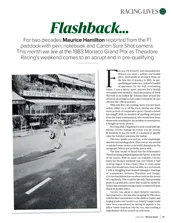Way off the pace on the opening day, Lauda and Watson were wasting their time on Saturday, for rain meant that Thursday’s times were now ‘The Grid’. As Niki and John headed home prematurely, and Marlboro’s countless guests wondered who they were going to root for, Prost was confirmed as pole man for Renault, followed by Amoux, Cheever, Tambay, Rosberg, Nelson Piquet in a Brabham-BMW, Andrea de Cesaris’ Alfa and Laffite.
In the wet conditions of the final session, though, Rosberg was fastest of all: “I wasn’t optimistic about the race, but I knew that at least there was the chance of rain on race day. That seemed to be our best hope.”
On Sunday morning it looked, as Mario Andretti puts it, like the Man Upstairs had been listening, for the sky was grey, and for a long time it rained. But by 12.30, warm-up time, the track had begun to dry out a little; Tambay duly set the fastest time, followed by Riccardo Patrese in the other Brabham-BMW, Amoux, Prost, Rosberg and Piquet. And what made Keke’s session different from anyone else’s was that he alone had tried slicks — so he alone knew how much grip there was.
“More than you’d have thought, actually,” he explained. “Now what I was really hoping for was uncertain conditions at race time. Basically, it seemed to me that if I had to start on the same tyres as the turbo guys — wets or slicks — I wasn’t going to have any chance. My only hope was to gamble, to have something different from them.”
Back then, Prince Rainier’s post-luncheon digestion was considered more important even than TV schedules, and the start at Monaco was always unusually late, at 3.30. As the afternoon slipped by, so spots of rain began to fall again and, as race time neared, the teams were in a quandary: the track was wet, yet the predicted downpour had not materialised. Out on the grid, the outpsyching began. Williams, however, had no doubts on the subject: Rosberg wanted slicks; Laffite followed suit. If the rain eased, they would obviously be in good shape — but would they be able to live with the wet-shod turbos in the early laps?

